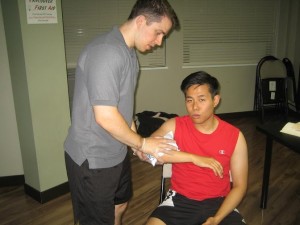Always bear in mind that wound care can be carried out without requiring professional medical care. The measures in cleaning and protection against infection are simple to perform. The indications to watch out for when to seek medical care are easy to distinguish. Whether it is a minor scrape on the knee, cut from a knife or puncture wound after stepping on a nail, it is vital to take into consideration certain factors.
Proper cleansing of the wound
The main objective in cleansing a wound is to take away any leftover foreign material and avoiding the entry of debris into the wound. You have to flush out dirt and debris using clean, cool water. All you have to do is use running water or immerse the wound in a basin or tub of water.
You can utilize soap when cleaning the skin around the wound, but take care not to allow it to enter the wound. Always ensure that the affected tissue is no longer irritated as much as possible.
Foreign bodies

In case visible dirt or other foreign particles are present in the wound, you can easily take them out using tweezers and rinse using isopropyl alcohol. It is vital to avoid using a strong agent such as hydrogen peroxide that can damage the healthy tissue and irritate the wound.
Bleeding
Take note that bleeding is actually beneficial since it helps flush dirt or debris from the wound. In case the bleeding persists, you have to apply pressure on the wound using clean gauze, tissue or cloth to control the bleeding. If possible, raise the wound higher than the level of the heart to stop the bleeding as well.
Covering the wound
In case a wound is not under any clothing where it can be irritated by rubbing, simply keep it open since air can help promote the healing process. If the wound is under clothing or on the hands where it has the potential to become infected, you have to apply a sterile dressing and change it on a daily basis.
Scrapes that cover a large area should be covered and kept moist using occlusive bandages that are readily available at local drug stores. These bandages help speed up the healing, keep the affected area free from germs as well as protect against scarring. An antibiotic ointment is not always required but is always a good option.
When to seek help
Oftentimes, there are certain circumstances where it is best to seek medical care for a cut. In case the bleeding could not be controlled, the wound is deep or the borders of the wound could not stay together, it is best to seek medical care.
Warmth at the wound, redness, swelling and persistent pain are the usual indications of infection that requires proper care by a doctor. When it comes to a puncture wound, it is recommended to get a tetanus shot if the individual has not received one in the past few years. In addition, a tetanus booster is required within 48 hours after sustaining a puncture wound.
